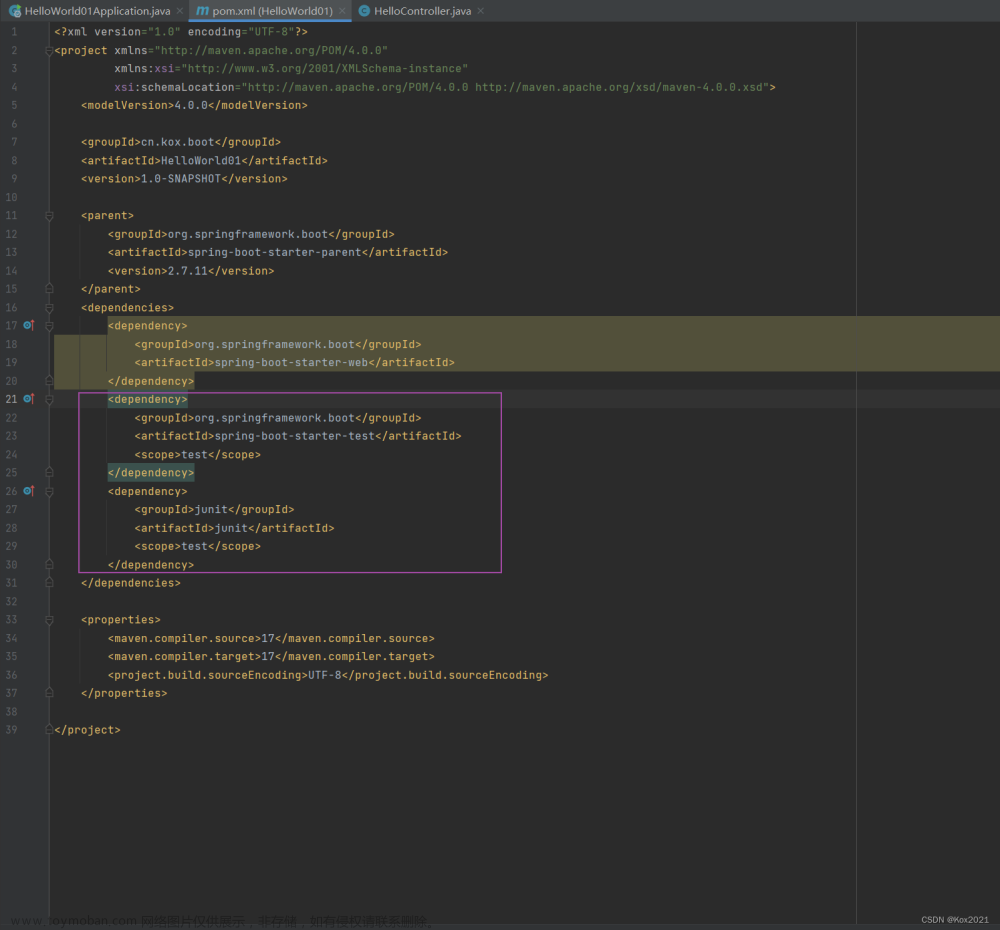引言:
在当今软件开发领域,单元测试已经成为确保应用质量和可维护性的关键步骤。特别是在Java生态系统中,Spring Boot框架作为一种广泛应用的解决方案,其对于单元测试的支持更是让开发者受益匪浅。本博客的目标是为开发者提供一份清晰易懂的指南,帮助他们利用Spring Boot框架构建健壮的Java应用,并编写高质量的单元测试。
首先,我们将探讨单元测试的重要性以及它在现代软件开发中的作用。随后,我们会深入了解Spring Boot框架对单元测试的支持,并介绍一些基本的概念和工具,例如JUnit和Mockito框架,以及Spring Boot测试相关的注解和工具。
通过本博客,读者将学习如何配置Spring Boot单元测试环境,包括依赖配置、测试类和方法的基本结构,以及如何使用Mockito进行模拟对象设置。我们还将讨论如何使用@SpringBootTest注解进行集成测试,确保不同组件之间的交互正常运行。
在测试Spring Boot中的不同组件方面,我们将分别探讨控制器层、服务层和数据访问层的测试方法,并介绍组件和集成测试的实践。在此基础上,我们将深入研究测试中的常见场景和最佳实践,包括异常处理、安全性、事务性和测试覆盖率分析等方面。
除了基础知识和常见场景外,我们还将涉及一些高级主题和工具,例如参数化测试、测试配置属性、异步代码的测试以及使用Testcontainers进行集成测试等。这些内容将帮助读者更全面地了解如何编写高效的单元测试。
最后,我们将讨论单元测试在持续集成过程中的应用,并提供一些关于如何在CI/CD流程中集成单元测试的实用建议。结语部分将强调单元测试对于确保Spring Boot应用质量和可维护性的重要性,并鼓励读者将其作为开发过程的一部分。同时,我们还将提供进一步学习资源和文档链接,以便读者深入学习和实践单元测试的相关知识。
第一部分:单元测试基础
定义单元测试
单元测试是软件开发中的一种测试方法,旨在验证程序的各个独立单元(函数、方法、类等)是否按照预期工作。在单元测试中,通常会对代码的每个功能模块进行测试,并针对每个单元编写测试用例,以确保其行为符合预期。
单元测试的优点
单元测试具有多方面的优点。首先,它可以帮助发现代码中的错误和潜在问题,提高代码的质量和可靠性。其次,单元测试可以促进代码的重构和改进,因为开发者可以放心地修改代码,而不必担心破坏现有功能。此外,单元测试还可以作为文档,帮助理解代码的行为和功能。最重要的是,它可以节省时间和成本,因为它可以在开发过程中快速捕获问题,避免将问题留到后期。
JUnit框架简介
JUnit是一个广泛用于Java应用程序中的单元测试框架,它提供了一组注解和断言来编写和运行测试用例。JUnit具有简单易用的特点,并且被广泛支持和使用。通过JUnit,开发者可以轻松地编写和运行单元测试,并且可以方便地集成到各种构建工具和开发环境中。
Mockito框架简介
Mockito是一个流行的Java框架,用于模拟对象,以便在单元测试中轻松地模拟依赖关系。通过Mockito,开发者可以创建模拟对象,并指定它们的行为,以模拟实际场景中的各种情况。Mockito提供了丰富的API和灵活的功能,使得编写单元测试变得更加简单和高效。
Spring Boot测试相关的注解和工具
Spring Boot框架提供了一系列注解和工具,用于简化单元测试的编写和执行。其中包括@SpringBootTest注解,用于标识整个应用程序的集成测试;@DataJpaTest注解,用于测试JPA数据访问层;@MockBean注解,用于创建模拟对象并注入到Spring容器中等。这些注解和工具可以帮助开发者轻松地编写各种类型的单元测试,并确保应用程序的各个组件正常工作。
第二部分:配置Spring Boot单元测试环境
依赖配置
在配置Spring Boot单元测试环境时,首先需要在项目的构建工具(如Maven或Gradle)中添加必要的依赖。通常,我们会引入JUnit和Mockito作为测试框架的依赖,并根据需要添加其他测试相关的库,如Spring Boot Test Starter。
在Maven项目中,可以在pom.xml文件中添加以下依赖:
<dependency>
<groupId>org.springframework.boot</groupId>
<artifactId>spring-boot-starter-test</artifactId>
<scope>test</scope>
</dependency>
<dependency>
<groupId>org.mockito</groupId>
<artifactId>mockito-core</artifactId>
<scope>test</scope>
</dependency>
在Gradle项目中,可以在build.gradle文件中添加以下依赖:
testImplementation 'org.springframework.boot:spring-boot-starter-test'
testImplementation 'org.mockito:mockito-core'
测试类和方法的基本结构
编写单元测试时,需要创建测试类,并在其中编写测试方法。测试类通常与被测试的类相对应,并使用Test或Test后缀来命名。测试方法以@Test注解标注,并包含需要测试的代码逻辑。在测试方法中,通常使用断言来验证预期结果与实际结果是否一致。
import org.junit.jupiter.api.Test;
import static org.junit.jupiter.api.Assertions.assertEquals;
public class MyServiceTest {
@Test
public void testAdd() {
MyService myService = new MyService();
int result = myService.add(2, 3);
assertEquals(5, result);
}
}
使用Mockito设置模拟对象
Mockito框架可以帮助我们创建和管理模拟对象,以便在单元测试中模拟外部依赖或对象的行为。通过Mockito.mock()方法创建模拟对象,并使用when()和thenReturn()方法设置模拟对象的行为。
import static org.mockito.Mockito.*;
MyService mockService = mock(MyService.class);
when(mockService.add(2, 3)).thenReturn(5);
使用@SpringBootTest注解进行集成测试
@SpringBootTest注解用于指定一个Spring Boot应用程序的集成测试类。它会自动加载Spring应用程序上下文,并初始化所需的Bean,以便进行集成测试。在使用@SpringBootTest注解时,可以通过@Autowired或@MockBean注解注入所需的依赖,以进行测试。
import org.springframework.boot.test.context.SpringBootTest;
import org.springframework.boot.test.mock.mockito.MockBean;
@SpringBootTest
public class MyServiceIntegrationTest {
@MockBean
private MyDependency myDependency;
// Test methods
}
通过以上配置,我们可以轻松地配置Spring Boot单元测试环境,并编写高质量的单元测试,以确保应用程序的质量和可维护性。
第三部分:测试Spring Boot中的不同组件
控制器层测试(使用MockMvc进行Web层测试)
在Spring Boot应用中,控制器层是与外部请求交互的入口点,因此需要对其进行充分的测试以确保其行为符合预期。可以使用Spring MVC的MockMvc类来模拟HTTP请求,并验证控制器的行为和返回结果。
import org.junit.jupiter.api.Test;
import org.springframework.beans.factory.annotation.Autowired;
import org.springframework.boot.test.autoconfigure.web.servlet.AutoConfigureMockMvc;
import org.springframework.boot.test.context.SpringBootTest;
import org.springframework.test.web.servlet.MockMvc;
import static org.springframework.test.web.servlet.request.MockMvcRequestBuilders.*;
import static org.springframework.test.web.servlet.result.MockMvcResultMatchers.*;
@SpringBootTest
@AutoConfigureMockMvc
public class MyControllerTest {
@Autowired
private MockMvc mockMvc;
@Test
public void testGetUser() throws Exception {
mockMvc.perform(get("/users/1"))
.andExpect(status().isOk())
.andExpect(jsonPath("$.id").value(1));
}
}
服务层测试(模拟依赖,测试业务逻辑)
服务层包含应用程序的业务逻辑,通常依赖于其他组件或服务。在单元测试中,可以使用Mockito框架来模拟这些依赖,并测试服务层的业务逻辑。
import org.junit.jupiter.api.Test;
import org.mockito.InjectMocks;
import org.mockito.Mock;
import org.springframework.boot.test.context.SpringBootTest;
import static org.mockito.Mockito.when;
@SpringBootTest
public class MyServiceTest {
@Mock
private MyRepository myRepository;
@InjectMocks
private MyService myService;
@Test
public void testGetUser() {
when(myRepository.findById(1L)).thenReturn(Optional.of(new User(1L, "John")));
User user = myService.getUser(1L);
assertEquals("John", user.getName());
}
}
数据访问层测试(使用H2等内存数据库)
数据访问层负责与数据库进行交互,因此需要对其进行充分的测试以确保数据的正确性和一致性。可以使用内存数据库如H2来进行数据访问层测试,并确保测试数据的独立性和可重复性。
import org.junit.jupiter.api.Test;
import org.springframework.beans.factory.annotation.Autowired;
import org.springframework.boot.test.autoconfigure.orm.jpa.DataJpaTest;
import static org.assertj.core.api.Assertions.assertThat;
@DataJpaTest
public class MyRepositoryTest {
@Autowired
private MyRepository myRepository;
@Test
public void testFindById() {
MyEntity entity = new MyEntity();
entity.setId(1L);
entity.setName("John");
myRepository.save(entity);
MyEntity found = myRepository.findById(1L).orElse(null);
assertThat(found).isNotNull();
assertThat(found.getName()).isEqualTo(entity.getName());
}
}
组件和集成测试(测试多个层次的交互)
组件和集成测试旨在测试多个组件之间的交互和整合,以确保整个系统的功能和性能。在Spring Boot应用中,可以通过组合不同层的测试来进行组件和集成测试,从而全面验证系统的行为。
@SpringBootTest
public class MyIntegrationTest {
@Autowired
private MockMvc mockMvc;
@Autowired
private MyService myService;
@Test
public void testUserFlow() throws Exception {
mockMvc.perform(get("/users/1"))
.andExpect(status().isOk())
.andExpect(jsonPath("$.id").value(1));
verify(myService, times(1)).getUser(1L);
}
}
通过以上测试方法,可以全面地覆盖Spring Boot应用中的不同组件,并确保其功能的正确性和可靠性。
第四部分:测试常见场景和最佳实践
异常处理测试
在Spring Boot应用中,异常处理是一个重要的方面,需要确保异常能够被正确捕获和处理。在单元测试中,可以模拟触发异常的情况,并验证异常处理器的行为是否符合预期。
import org.junit.jupiter.api.Test;
import org.springframework.beans.factory.annotation.Autowired;
import org.springframework.boot.test.context.SpringBootTest;
import org.springframework.boot.test.web.client.TestRestTemplate;
import org.springframework.http.ResponseEntity;
import static org.junit.jupiter.api.Assertions.assertEquals;
@SpringBootTest(webEnvironment = SpringBootTest.WebEnvironment.RANDOM_PORT)
public class ExceptionHandlingTest {
@Autowired
private TestRestTemplate restTemplate;
@Test
public void testHandleException() {
ResponseEntity<String> response = restTemplate.getForEntity("/error", String.class);
assertEquals(500, response.getStatusCodeValue());
assertEquals("Internal Server Error", response.getBody());
}
}
安全性测试(使用Spring Security Test)
Spring Boot应用中的安全性是至关重要的,特别是对于需要身份验证和授权的功能。Spring Security Test模块提供了用于测试安全配置的工具和支持,可以模拟用户的认证和授权行为,并验证安全性配置的正确性。
import org.junit.jupiter.api.Test;
import org.springframework.beans.factory.annotation.Autowired;
import org.springframework.boot.test.context.SpringBootTest;
import org.springframework.security.test.context.support.WithMockUser;
import org.springframework.test.web.servlet.MockMvc;
import static org.springframework.test.web.servlet.request.MockMvcRequestBuilders.*;
import static org.springframework.test.web.servlet.result.MockMvcResultMatchers.*;
@SpringBootTest
public class SecurityTest {
@Autowired
private MockMvc mockMvc;
@Test
@WithMockUser(username = "user", password = "password", roles = "USER")
public void testAuthorizedAccess() throws Exception {
mockMvc.perform(get("/secure"))
.andExpect(status().isOk());
}
@Test
public void testUnauthorizedAccess() throws Exception {
mockMvc.perform(get("/secure"))
.andExpect(status().isUnauthorized());
}
}
事务性测试
在Spring Boot应用中,事务管理是保持数据一致性和完整性的关键。在单元测试中,可以测试事务的回滚和提交行为,以确保事务管理的正确性。
import org.junit.jupiter.api.Test;
import org.springframework.beans.factory.annotation.Autowired;
import org.springframework.boot.test.autoconfigure.jdbc.AutoConfigureTestDatabase;
import org.springframework.boot.test.autoconfigure.orm.jpa.DataJpaTest;
import org.springframework.transaction.annotation.Transactional;
import static org.assertj.core.api.Assertions.assertThat;
@DataJpaTest
@AutoConfigureTestDatabase(replace = AutoConfigureTestDatabase.Replace.NONE)
@Transactional
public class TransactionalTest {
@Autowired
private MyRepository myRepository;
@Test
public void testSaveAndRollback() {
MyEntity entity = new MyEntity();
entity.setName("John");
myRepository.save(entity);
assertThat(myRepository.findById(entity.getId())).isPresent();
}
}
测试覆盖率分析(使用Jacoco等工具)
测试覆盖率分析是评估测试套件覆盖代码的程度的重要指标。通过工具如Jacoco,可以生成测试覆盖率报告,并识别未被测试覆盖的代码,以便进一步改进测试覆盖度。
<plugin>
<groupId>org.jacoco</groupId>
<artifactId>jacoco-maven-plugin</artifactId>
<version>0.8.7</version>
<executions>
<execution>
<goals>
<goal>prepare-agent</goal>
</goals>
</execution>
<execution>
<id>report</id>
<phase>prepare-package</phase>
<goals>
<goal>report</goal>
</goals>
</execution>
</executions>
</plugin>
通过这些测试常见场景和最佳实践,开发者可以全面地测试Spring Boot应用的各个方面,并确保其质量和可靠性。
第五部分:高级主题和工具
参数化测试(使用JUnit 5的@ParameterizedTest)
参数化测试是一种测试方法,可以使用不同的输入参数多次运行相同的测试方法,从而减少重复代码并增加测试覆盖率。在JUnit 5中,可以使用@ParameterizedTest注解来实现参数化测试,并使用@ValueSource等注解指定参数。
import org.junit.jupiter.params.ParameterizedTest;
import org.junit.jupiter.params.provider.ValueSource;
import static org.junit.jupiter.api.Assertions.assertTrue;
public class ParameterizedTestExample {
@ParameterizedTest
@ValueSource(ints = {1, 2, 3})
public void testIsPositive(int number) {
assertTrue(number > 0);
}
}
测试配置属性(@TestPropertySource和@TestConfiguration)
在单元测试中,有时需要指定特定的配置属性以便于测试,如数据库连接配置、日志级别等。@TestPropertySource注解可以指定测试属性文件的位置,而@TestConfiguration注解可以用来指定测试专用的配置类。
import org.springframework.boot.test.context.SpringBootTest;
import org.springframework.test.context.TestPropertySource;
@SpringBootTest
@TestPropertySource(locations = "classpath:test.properties")
public class ConfigPropertyTest {
// Test methods
}
异步代码的测试
Spring Boot应用中常常会涉及到异步代码,如异步方法、异步消息处理等。在单元测试中,需要特别注意对异步代码的测试。可以使用CompletableFuture或Mockito的异步方法来测试异步代码的行为。
import org.junit.jupiter.api.Test;
import org.springframework.beans.factory.annotation.Autowired;
import org.springframework.boot.test.context.SpringBootTest;
import java.util.concurrent.CompletableFuture;
import static org.junit.jupiter.api.Assertions.assertEquals;
@SpringBootTest
public class AsyncTest {
@Autowired
private AsyncService asyncService;
@Test
public void testAsyncMethod() throws Exception {
CompletableFuture<Integer> future = asyncService.doSomethingAsync();
int result = future.get();
assertEquals(42, result);
}
}
使用Testcontainers进行集成测试
Testcontainers是一个Java库,可以方便地在单元测试中启动和管理容器化的服务,如数据库、消息队列等。在Spring Boot应用的集成测试中,可以使用Testcontainers来启动容器化的数据库,以便进行更真实的集成测试。
import org.junit.jupiter.api.Test;
import org.springframework.beans.factory.annotation.Autowired;
import org.springframework.boot.test.context.SpringBootTest;
import org.springframework.boot.test.util.TestPropertyValues;
import org.springframework.context.ApplicationContextInitializer;
import org.springframework.context.ConfigurableApplicationContext;
import org.testcontainers.containers.MySQLContainer;
import org.testcontainers.junit.jupiter.Container;
import org.testcontainers.junit.jupiter.Testcontainers;
import static org.junit.jupiter.api.Assertions.assertEquals;
@SpringBootTest
@Testcontainers
public class ContainerizedDatabaseTest {
@Container
private static final MySQLContainer<?> mySQLContainer = new MySQLContainer<>("mysql:8.0");
@Autowired
private MyRepository myRepository;
static class Initializer implements ApplicationContextInitializer<ConfigurableApplicationContext> {
public void initialize(ConfigurableApplicationContext configurableApplicationContext) {
TestPropertyValues.of(
"spring.datasource.url=" + mySQLContainer.getJdbcUrl(),
"spring.datasource.username=" + mySQLContainer.getUsername(),
"spring.datasource.password=" + mySQLContainer.getPassword()
).applyTo(configurableApplicationContext.getEnvironment());
}
}
@Test
public void testSave() {
MyEntity entity = new MyEntity();
entity.setName("John");
myRepository.save(entity);
MyEntity savedEntity = myRepository.findById(entity.getId()).orElse(null);
assertEquals("John", savedEntity.getName());
}
}
通过掌握这些高级主题和工具,开发者可以更加灵活和高效地编写Spring Boot应用的单元测试,并确保其质量和可维护性。
第六部分:持续集成与单元测试
在CI/CD流程中集成单元测试
持续集成(Continuous Integration,CI)是一种软件开发实践,通过将代码的集成与测试自动化,可以确保代码的及时集成和质量保证。在CI/CD流程中,将单元测试作为关键步骤之一,可以在每次代码提交后自动运行单元测试,并及时发现和修复潜在的问题。
使用Maven或Gradle插件自动运行测试
Maven和Gradle是两种常用的构建工具,都提供了用于执行单元测试的插件。通过配置构建脚本,可以实现在构建过程中自动运行单元测试,并将测试结果输出为报告。
在Maven中,可以使用Surefire插件来执行单元测试,并生成测试报告。示例配置如下:
<plugins>
<plugin>
<groupId>org.apache.maven.plugins</groupId>
<artifactId>maven-surefire-plugin</artifactId>
<version>3.0.0-M5</version>
<configuration>
<!-- 配置单元测试执行参数 -->
</configuration>
</plugin>
</plugins>
在Gradle中,可以使用Test任务来执行单元测试。示例配置如下:
test {
// 配置单元测试执行参数
}
测试结果报告和分析
自动化运行单元测试后,需要对测试结果进行报告和分析,以便及时发现问题并进行修复。通常可以生成HTML、XML等格式的测试报告,并结合其他工具进行分析。
在Maven中,Surefire插件可以生成XML格式的测试报告,而Jacoco插件可以生成测试覆盖率报告。示例配置如下:
<plugins>
<plugin>
<groupId>org.apache.maven.plugins</groupId>
<artifactId>maven-surefire-plugin</artifactId>
<version>3.0.0-M5</version>
<configuration>
<!-- 配置生成XML格式的测试报告 -->
</configuration>
<reporting>
<plugins>
<plugin>
<groupId>org.jacoco</groupId>
<artifactId>jacoco-maven-plugin</artifactId>
<version>0.8.7</version>
</plugin>
</plugins>
</reporting>
</plugin>
</plugins>
在Gradle中,通过配置Test任务和Jacoco插件,可以生成测试报告和测试覆盖率报告。示例配置如下:
test {
// 配置生成HTML格式的测试报告
}
jacocoTestReport {
// 配置生成HTML格式的测试覆盖率报告
}
通过持续集成和自动化测试结果报告分析,可以及时发现问题并持续改进代码质量,保障Spring Boot应用的可靠性和可维护性。
结语:
在现代软件开发中,单元测试是确保应用程序质量和可维护性的重要组成部分。通过本文中介绍的Spring Boot单元测试的基础知识、配置方法以及高级主题和工具,我们希望能够帮助开发者编写高质量的Java应用程序。
通过编写单元测试,开发者可以有效地验证代码的正确性、改进代码的设计,并在开发过程中提前发现和解决潜在的问题。Spring Boot框架提供了丰富的支持和工具,使得编写和运行单元测试变得更加简单和高效。
我们鼓励读者将单元测试纳入开发工作流程的一部分,并在实际项目中广泛应用。除了本文介绍的内容之外,还可以深入学习其他相关主题,如持续集成、测试驱动开发等,以进一步提升软件开发的水平。
最后,为了帮助读者进一步学习和探索,我们提供了一些相关的学习资源和文档链接。希望读者能够通过不断学习和实践,成为精通Spring Boot单元测试的技术专家,构建更加健壮和可靠的Java应用程序。
附录:
-
相关工具和框架的链接:文章来源:https://www.toymoban.com/news/detail-840239.html
- JUnit官方网站
- Mockito官方网站
- Spring Boot官方网站
- Spring Security Test文档
-
推荐阅读的书籍和在线资源:文章来源地址https://www.toymoban.com/news/detail-840239.html
-
书籍:
- “Effective Unit Testing: A guide for Java developers” by Lasse Koskela
- “Spring Boot in Action” by Craig Walls
- “JUnit in Action” by Vincent Massol, Gary Gregory
-
在线资源:
- Baeldung
- Spring Guides
- JUnit 5 User Guide
-
书籍:
到了这里,关于精通Spring Boot单元测试:构建健壮的Java应用的文章就介绍完了。如果您还想了解更多内容,请在右上角搜索TOY模板网以前的文章或继续浏览下面的相关文章,希望大家以后多多支持TOY模板网!










